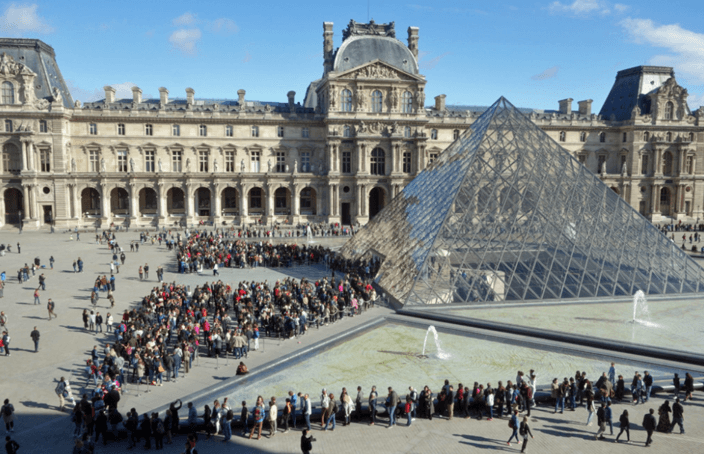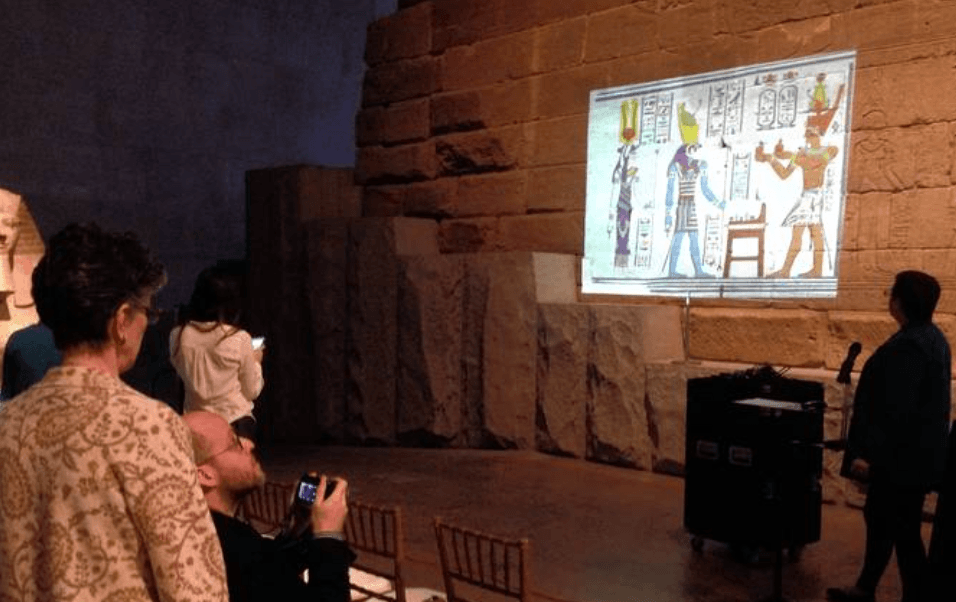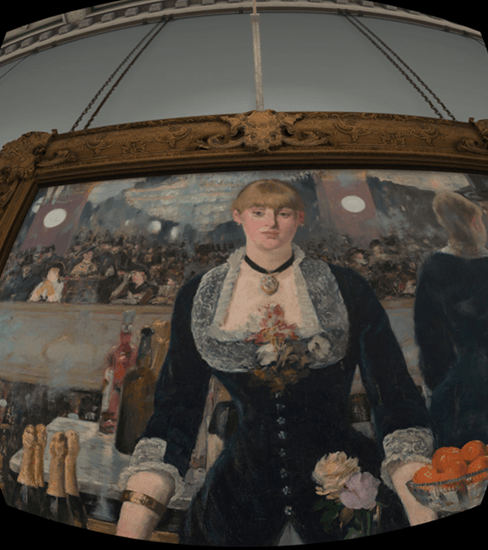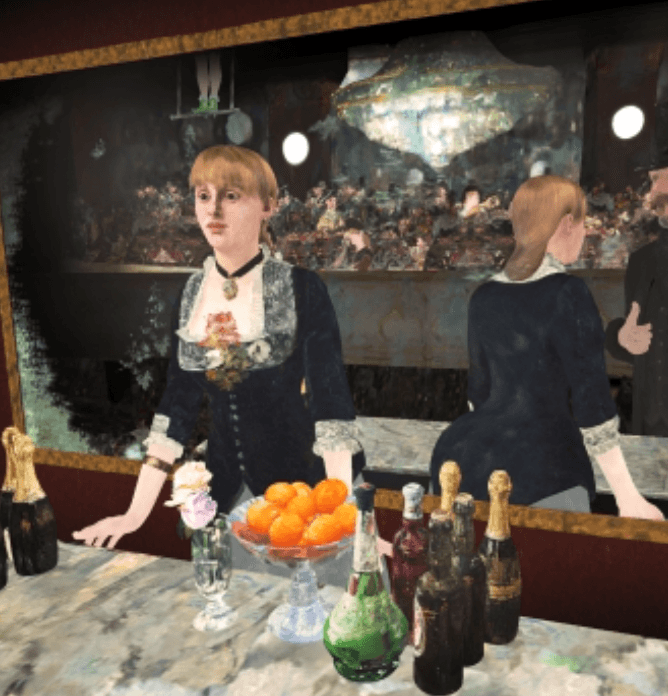Why VR could mean the end of Art museums

Do you enjoy the experience surrounding the visit of a museum? Virtual Reality (VR) headsets are slowly emerging as a substitute to visiting art galleries, potentially threatening museums’ business model.
So you’ve finally made it to Paris, France. You wake up the next day, on Sunday, and bring your family to the Louvre museum at around 10AM, and this is what you see….1.5hr line.

Fig. 1. Line outside the Louvre
You tell yourself, 1.5hr line is fine, as long as you can see the famous Mona Lisa painting you’ve heard so much about. But this is what you actually end up looking at…lots of camera screens, not much of the painting itself.
 Fig. 2. Inside the Mona Lisa room – Le Louvre museum.
Fig. 2. Inside the Mona Lisa room – Le Louvre museum.
Does this sound familiar? The experience surrounding the visit of a museum is often disappointing for a number of reasons, but up to now no clear alternatives were available. Virtual Reality (VR) headsets are slowly emerging as a substitute to visiting art galleries, potentially threatening museums’ business model.

Fig. 3. Oculus Rift headset
Manufacturers such as Samsung, Oculus Rift, and Sony are bringing to market VR headsets that enable immersive experience from any location. It isn’t hard to imagine how this technology could adversely impact museums’ business model, not just by removing several of the pain points that affect the museum experience but also by making the experience more interactive and exciting in a way a museum can’t.
How are the museums responding to this digital transformation?
One might think that because museums are often nonprofit, they might not care much about a reduction in the number of visitors. While largely funded by state subsidy and private donations, museums still rely heavily on ticket sales to meet their budget. For the Louvre museum, 28% of its 216m€ revenue in 2012 came from ticket sales [1] (in line with the 31% average figure reported by the American Alliance of Museums in 2006 [2]). As such, to continue funding their operations and acquire new Art pieces, museums have come up with ways to attract visitors, often adding a layer of digital to their existing installations.
Play it safe – improve existing audioguide offering
Most museums propose audio guides to visitors as a way to enhance their experience, but these guides do not generate significant revenue. The Louvre offers a free mobile app, and a 5€ Nintendo 3DS version that you can rent in place of the usual audio guides. Only 4% of the 8.5 million annual visitors choose to rent the available audio guides, generating a paltry 1.7m€ in yearly revenue [3]. Audiences want to be engaged, but an incremental evolution of the audio guide probably isn’t enough.

Fig. 4. Museum Australia Innovation Study (2014) [4]
Experiment in exhibit designs
Some museums have started to mix physical objects with basic digital tools, Fig. 5. shows the example of the Metropolitan Museum of Art in New York which uses projection mapping to reimagine how the museum’s Temple of Dendur looked like. Again, incremental in nature, these changes do not appear to radically enhance the visitor’s experience.

Fig 5. Metropolitan Museum of Art in New York, Temple of Dendur section
Integrate VR into the museum experience
The British Museum uses virtual reality to transport visitors to the bronze age. It allows visitors to explore an historical site featuring objects from the museum’s collection that have been 3D scanned and placed in their original setting.

Fig 6. Interior of a virtual reality Bronze Age roundhouse [5]
While offering a VR experience helps engage visitors, it does not solve the issue of accommodating a large number of visitors in a given location. Also, once the virtual world has been created and could thus be accessed from home, the appeal to physically come to the museum is reduced.
Comes in the “Netflix of the Arts”
WoofbertVR [6], a startup ran by a MoMA curator, has partnered with leading museums to offer virtual museum tours accessible to all online. Called the “Netflix of the Arts” by Forbes, it is free for the moment (as museums provide their Art rights for free), but has indicated that it will charge a fee at some point.

Fig 7. Close up view of a painting by Edouard Manet – A Bar at the Folies-Bergère in the VR world.
WoofbertVR also enables users to step into the painting and be absolutely immersed within the scene.

Fig 8. Once in the painting
WoofbertVR is a great example of what the combination of VR headsets and the internet could offer beyond just seeing up close Art.
Additional steps
All previously discussed onsite digital experiences proposed by museums do not appear to radically enhance the value proposition of coming to the museum, nor generate additional revenue for the moment. While VR could be perceived as a threat to museums, it could also be viewed as a tool to democratize access to Art, in turn encouraging people to see the real Art pieces at the museums afterwards. In any case, museums should rethink their business and operating model, and consider licensing the rights to “view” their museums in the digital world, as this could become a new important revenue stream. One caveat to that, observing how the digital transformation operated in the entertainment and music industry with Netflix and iTunes, museums should consider not letting a single 3rd party owned platform monopolize the majority of the market, in turn building a large bargaining power.
(796 words)
Sources
[1] http://www.louvre.fr/en/missions-projects
[2] http://futureofmuseums.blogspot.com/2009/03/forecasting-financial-future-of-museums.html
[3] http://newatlas.com/louvre-nintendo-3ds-tour-guide/20877/
[5] https://www.theguardian.com/culture/2015/aug/04/british-museum-virtual-reality-weekend-bronze-age and http://vrscout.com/news/british-museum-virtual-reality-tours/



Very interesting article about the use of technology in a very antiquated field. I question though will VR in the museum be successful. Why buy a VR and not just Google Image the painting? What is next for VR: zoos? baseball games? There is something to say for actually getting to experience where you are. Part of seeing the Mona Lisa is not just to see the Mona Lisa, but to get to be physically present at one of the homes of art in the world. While, VR could be a great way to introduce art, I struggle to accept that this is the future of museums.
Fascinating article. It would be interesting to explore further what the customer motivations behind going to museums are. If, as you mentioned, the lines are so long and the experience so poor, are they really going for the educational experience? Perhaps it is the attraction of seeing the Mona Lisa, for example, in real life, with their own eyes.
The attached piece by the American Alliance of Museums suggests some motivations which may not be replaced by digital – surely, as you point out, they are only one part of the story.
http://aam-us.org/about-museums/museum-facts
The potential decline in museum goers due to access to the exhibits via VR could be incredibly worrisome, though I’m not completely convinced that museums will suffer when it’s all said and done. I would like to think that there is still intrinsic value in seeing and experiencing the exhibits first hand, and that consumers will continue to flock to museums. However, it is compelling that museums could partner with VR platforms to lease or license the right to show the exhibits, thus opening up potential new market segments and reducing wait times at the museums themselves. Museums could also invest in partnerships with local restaurants or other sights in order to increase the value of in-person visits as well.
I agree with your thesis that the experience surrounding the visit of museums can be quite annoying. In your article you did not mention the risk of piracy, which is something museums should be worried of in my own opinion. Doing some research, I already found an occulus Rift VR file for visiting the Mona Lisa room, for free (http://www.vrcircle.com/post/mona-lisa-room-oculus-rift-vr-experience). Does this seem like it could be concern?
Interesting article. I agree the museums should be weary of allowing a single player to monopolize a potential museum VR platform, but a concern I have for this not occurring is the limitations of many copy right laws. Once VR technology becomes more widely spread I could see every major attraction within museums digitized and then made available online. All the users would have to say is the website is dedicated to education and commentary and I believe it would be difficult for the museums to fight, especially if they start to experience significant declines in revenue/resources.
I hope that there never comes a point in time where museum goers trade in a trip to the museum for a pair of VR glasses. Visiting a museum is more about the experience. Curators spend their lives figuring out the perfect way to arrange art so that the light hits it in just the right way, and I don’t think this could ever be captured through a computer. Looking at Monet’s Haystacks new colors emerge as the sun sets. Digital mediums just can’t capture that. Plus part of the joy of going to a museum is connecting with a piece of art that isn’t famous that is simply special because in that moment it means something to the viewer. If all museum goers decide to trade in a trip to the museum for virtual reality, viewers will only see what the VR company has deemed is popular and a lot of beautiful/important, but less well known artwork will become forgotten. While I think that things like virtual reality and internet displays are important because all people should have access to art, I worry that the shift towards digitization will harm smaller museums. Museums like the Louvre or the Met are not suffering from a lack of visitors…if they were you wouldn’t have to wait in the 1.5 hour line. The museums that suffer the most are the small local museums that may have one or two famous pieces in their collection, but not nearly the breadth of other museums. I worry that these small museums will be hurt by the use of virtual reality in art. These museums cannot afford to invest in the technology that the large museums can invest in, nor do they have the budgets to prevent VR companies from placing their works online.
Really interesting thesis – I do agree with some of the above comments that personally I hope this does not happen! My theory is that it will cut into attendance, but for some it will always be an experience that going to the real deal will always beat something digital. My support for this is that significant upgrades in television technology has not destroyed the market for attending a sporting event in person. Arguably, watching a football game on TV is just as good, if not better than, attending in person. No annoying lines, inclement weather, and probably even better views of the action.
On how museums should respond – I think you can continue with the sports analogy. In almost every professional sports stadium, there are video boards that show replays, or better angles of a live play if your seats do not give you a great view of the play given where the play is taking place. You point it out in the post, but I think incorporating VR is a great way to enhance the in-person experience and protect against out-of-museum use of the technology.
Interesting article! While I share Ellyn’s concerns about small museums and also about the experience not being nearly the same, this progression feels inevitable to me. If museums were able to charge for VR access to their art, would you recommend a subscription or one-time business model? Perhaps encouraging a subscription model could keep users for a longer period of time. Museums could also limit the amount of art a viewer could look at per trip to make the subscription model more compelling. Nevertheless, I still plan to attend in person!
First, I’d like to say I love the way you laid out the beginning of the article–having never been to the Louvre, I would never had imagined how immensely crowded it is! I think the VR angle will be a godsend for those not wanting to wait in line (or those who cannot afford to travel). However I, like the others who posted above, am skeptical of how much VR will actually detract from the museums’ bottom line. I still think that VR is seen as very gimmick-y (just as 3D movies/TV were supposed to be revolutionary, it seems that this sentiment has died). While people can “see” famous pieces of art using a simple google search, there’s a draw to being physically present with the specific masterpiece. I wonder if by making it more interactive/3D/virtual will be enough of an incremental improvement over seeing simple photos/reprints of art–after all, in both scenarios, you aren’t seeing the actual work of art but just a representation. One is just more realistic.
Perhaps this will turn out to be a good thing for museums should it really take off–museum halls will be less crowded and line will be shorter, and new streams of revenue can become available by licensing rights to incorporate famous works into the VR world. I do worry about smaller museums who might not have the same clout around their artwork, and thus draw smaller crowds. I’d be interested to learn if there has been much push-back from museums from this?